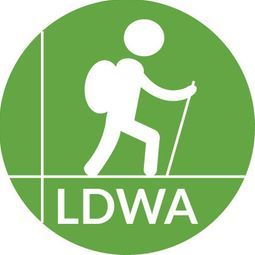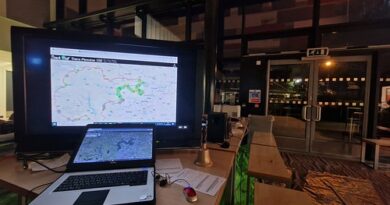LDWA 100 – Q & As with David Morgan
This page is all part of my effort to walk the 2021 LDWA 100.
In the first part of my new series of probing interviews (OK, not that probing, this isn’t the Daily Mail, although perhaps in a few months maybe the readers of this blog will demand sensationalism….) with experienced LDWA 100 walkers. And there can be few people more cool, calm and collected than the LDWA’s national chair, David Morgan. I can say, if there wasn’t an IT fund to raise money for, I suspect we in Norfolk & Suffolk might be raising money to fund a statue in somewhere like Fakenham of this towering walking figure.
My efforts to walk the 100 will be more like Alan Partridge, but they all count…. You can follow David on Twitter at https://twitter.com/ldwachair.
So, here we go. People may be surprised that I wrote these questions and not someone like Jeremy Paxman, as I feel they cover the important parts of walking.
Q. When was your first 100?
I entered my first 100 mile walk in 1995. I retired at the breakfast point and was wholly underprepared for the mental challenge that the Shropshire 100 offered. I’d not been required to complete a qualifier and I know that if I’d walked 50 miles, I’d have been better prepared. The first 100 that I finished was the Yorkshire Dales 100 in 1996.
Q. Were you nervous before starting that first 100?
I wouldn’t say that I was nervous, but I was apprehensive about the challenge that I faced.
Q. When you finished your first 100, did you think you’d do another?
I said ‘Never Again’. And we know what happened to that statement!!
Q. Is completing the 100 just as much about being a mental challenge as a physical one? What would you say to people who are easily distracted and might want to stop to pop in a pub or a Greggs en route?
I think that the 100 is definitely more of a mental challenge than a physical one. That’s not to underestimate the physical effort required, but it always seems possible to put one foot in front of the other if the mind tells you it’s possible.
Being distracted by food is a good thing! The way to approach that distraction is to convince yourself that you’re providing the body with calories for later on in the walk. If you have a pint, limit yourself to one. I know lots of people who have done that and I like to have a bottle at the finish waiting for me as an incentive!
Q. When you’re tired and parts of you are hurting which you don’t want to be hurting, how do you get the motivation to keep going?
It’s that mental battle again. Focus on the surroundings, the beauty of what you are walking through and take your mind off the pain that you might be experiencing. If it’s at night, it’s often possible to focus on views, particularly when high on a hill or gaze at the stars and enjoy what’s above!
Q. Have you hallucinated towards the end of a walk?
I’ve only hallucinated once and that was in 1996 on my first 100. I could see faces in rocks and as I climbed a large hill towards Malham, the path that had become very muddy in the rain became a pink colour.
Q. What practical advice do you have about foot care? For example, is Sudocrem useful and do you recommend changing socks regularly?
I don’t use Sudocrem on my feet; I save that for other body parts and use it liberally!
As for my feet, I always smear them with Vaseline and always wear two pairs of socks. One thin pair next to my feet and a slightly thicker pair on top of that. I change my socks and reapply Vaseline every 15-20 miles. I haven’t had a blister on a 100 in over five years since pursuing this approach.
Q. You get to a checkpoint and have to choose. Two sausage rolls or one steak bake?
Tough choice. Quantity or quality? I think I’d go for one steak bake!!
Q. Are your spirits lifted when being welcomed into LDWA checkpoints?
Definitely. LDWA volunteers on the 100 instinctively know what you need. The kindness and support offered is humbling. Wonderful people will take your mug and get a cup of tea whilst others will get you food. Others will see when entrants need a bit more TLC and will help them recover before sending them on their way. Marshals do not want to see people retiring at their checkpoints and will do everything they can to help people succeed.
Q. Is it acceptable to have a little craft beer when 80 miles into the 100 miles?
Definitely!! If it lifts your spirit, why not?!
Q. Do you prefer route descriptions or GPX?
I use both. I prefer to navigate by route description primarily, but use my GPS when a path junction is unclear. I prefer the route description because it helps to keep my mind active and to also ensure that I know exactly where I am in the route description. I particularly like to navigate at night time by the route description and often assume that 100 yards takes about 1 minute to walk. So, if I see a 1000 yard stretch, I can relax for about 8 minutes before ‘switching on’ and looking for the next feature.
Q. Have you been scared of a sheep / cow / snake / pig / seagull or similar on a challenge walk?
A badger ran out in front of me on the 2017 North Yorkshire Moors 100 and I jumped backwards as it startled me! I admit my heart did miss a beat!
Q. To those people who are thinking about taking part in their first challenge event, maybe just 18 miles, what advice would you give them?
Enjoy the experience, engage in conversation with other walkers, focus only on the next checkpoint, enjoy the hospitality that the LDWA is famous for and once you’ve finished, look forward to booking yourself onto the next adventure.




